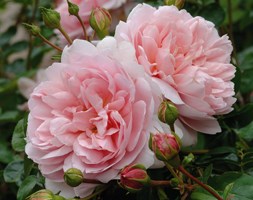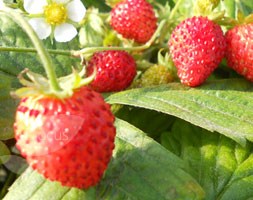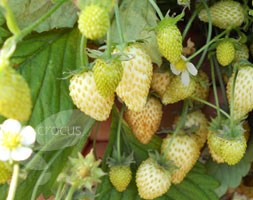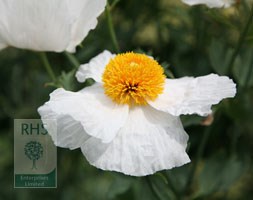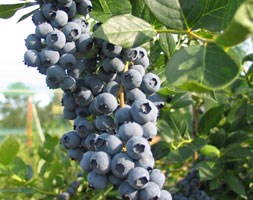New products at Crocus
by Sarah - July 24th, 2013.Filed under: Crocus, New Products.
New items added today at Crocus
Rosa Wildeve (‘Ausbonny’) (PBR) (English Rose) £25.99
Lovely blush pink buds open to rosette shaped blooms of pink touched with apricot. A particularly robust and healthy shrub that is covered in a mass of flowers during summer. It can be grown as a ground cover rose or a smaller shrub rose and is ideal for a less than perfect position in the garden. Position: full sun Soil: fertile, humus-rich, moist, well-drained soil Rate of growth: average Flowering period: June and September Flower colour: pink Other features: excellent cut flowers Hardiness: fully hardy Garden care: Before planting shorten thick roots to 25cm (10in) and reduce top-growth to an outward-facing bud 8-15cm (3-6in) above ground-level. Plant during a frost-free spell, incorporating well-rotted organic matter and a balanced fertiliser into the planting hole. Ensure that the ‘bud union’ (the bulge at the base of the shoots) is at soil level. Goes well with: Alchemilla mollis, Pulmonaria officinalis ‘Sissinghurst White’, Hesperis matronalis, Chionodoxa luciliae Gigantea Group, Allium sphaerocephalon, Clematis ‘Etoile Violette’
strawberry ‘Scarlet Beauty’ (alpine strawberry) £14.99
Position: full sun or lightly dappled shade Soil: any soil Rate of growth: fast-growing Other features: ready to pick from June Hardiness: fully hardy The fruit of this alpine strawberry may be smaller than those grown commercially, but what it lacks in size it makes up for in flavour. We have love it because not only does it make pretty groundcover at the front of the border, but it will also produce a bumper crop of deliciously sweet berries from early summer onwards. Where space is limited it will happily grow in pots or hanging baskets. Garden care: These strawberry runners are sent out as bare root (ie not potted up or in soil) plants. They are completely dormant, so any remaining foliage or stems will look shrivelled and dry. They should be planted out within a couple of days of arrival. Once they are planted out, they will emerge from their dormancy and start to put on new growth in spring (or within a 4 – 6 weeks if planted in spring). Choose a spot in full sun and prepare the bed well by removing all the weeds and digging in a generous amount of compost. You can also work in some general purpose fertiliser if planting in spring. When you are ready to plant, fill a bucket with tepid water and leave the plants to soak for 20 minutes. This will rehydrate the roots. While they are soaking, prepare the planting holes – these should be approximately twice as wide as the strawberries root system. Plant the strawberries so the crown (the point where the roots meet the stem) is at soil level, and spread the roots out before re-filling with soil. Space them at 45cm intervals, allowing 75cm between each row. After planting, immediately give them a thorough water and apply a generous layer of mulch around the base of the plants, being careful to avoid the crown. Keep the plants well watered, especially during warmer weather and when the fruits are developing. When the strawberries are starting to form, a thick layer of straw or a strawberry mulch mat can be placed under the plants to stop the fruit touching the soil. Sheets of black plastic mulch can also be used, and this will also help retain soil moisture, reduce weeds and encourage early cropping. Strawberries can also be planted in tubs, containers and hanging baskets.
strawberry ‘Leo Alba’ (alpine strawberry) £14.99
Position: full sun to light shade Soil: any soil Rate of growth: fast-growing Other features: ready to pick June / July Hardiness: fully hardy The unusual fruits of this alpine strawberry never ripen to red, but you will know they are ripe and ready to pick when they feel soft to the touch. Their flavour is unexpectedly refreshing too, sweet and delicate, with undertones of vanilla and pineapple. Smaller than the commercially grown strawberries, these have the advantage though of being able to crop over a much longer period in ideal conditions. Garden care: These strawberry runners are sent out as bare root (ie not potted up or in soil) plants. They are completely dormant, so any remaining foliage or stems will look shrivelled and dry. They should be planted out within a couple of days of arrival. Once they are planted out, they will emerge from their dormancy and start to put on new growth in spring (or within a 4 – 6 weeks if planted in spring). Choose a spot in full sun and prepare the bed well by removing all the weeds and digging in a generous amount of compost. You can also work in some general purpose fertiliser if planting in spring. When you are ready to plant, fill a bucket with tepid water and leave the plants to soak for 20 minutes. This will rehydrate the roots. While they are soaking, prepare the planting holes – these should be approximately twice as wide as the strawberries root system. Plant the strawberries so the crown (the point where the roots meet the stem) is at soil level, and spread the roots out before re-filling with soil. Space them at 45cm intervals, allowing 75cm between each row. After planting, immediately give them a thorough water and apply a generous layer of mulch around the base of the plants, being careful to avoid the crown. Keep the plants well watered, especially during warmer weather and when the fruits are developing. When the strawberries are starting to form, a thick layer of straw or a strawberry mulch mat can be placed under the plants to stop the fruit touching the soil. Sheets of black plastic mulch can also be used, and this will also help retain soil moisture, reduce weeds and encourage early cropping. Strawberries can also be planted in tubs, containers and hanging baskets.
Romneya coulteri (tree poppy) £9.99
Position: full sun Soil: fertile, well-drained soil Rate of growth: average Flowering period: July to October Flower colour: pure white with yellow centres Other features: handsome grey-green leaves Hardiness: frost hardy (needs winter protection) Papery, pure-white, poppy-like flowers with golden-yellow centres from July to October and handsome, deeply lobed, grey-green leaves. This wonderful, white tree poppy makes an excellent specimen plant for a sunny mixed border. Often slow to establish and resentful of disturbance, it requires fertile, well-drained soil, and shelter from strong winds. Can be propagated from root cuttings taken in the winter-early spring months. Garden care: Cut back flower stems close to the base in March. Provide a deep dry mulch in the winter months for protection.
blueberry ‘Liberty’ (PBR) (blueberry – late-season fruiting) £6.99
Position: full sun or partial shade Soil: prefers moist, well-drained, acidic soil or ericaceous compost in a pot. Rate of growth: average Other features: pink flowers fading to white in spring Hardiness: fully hardy Vigorous plants with a strongly upright habit and a good resistance to inclement weather, produce a bumper crop of sky-blue fruits late in the season. These large fruits ripen over a period of several weeks and once picked, have a good shelf-life. Each fruit has a delicious aroma and tasty flesh, making them a very popular choice. Garden care: Prepare the ground well before planting. Prune in winter, cutting out dead or damaged branches. In spring, feed with sulphate of ammonia, sulphate of potash and bonemeal and top-dress with ericaceous compost.







